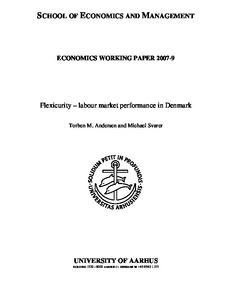Flexicurity - labour market performance in Denmark
"Unemployment is at a low and stable level in Denmark. This achievement is often attributed to the so-called flexicurity model combining flexible hiring and firing rules for employers with income security for employees. Whatever virtues this model may have, a low and stable unemployment rate is...
| Main Authors: | , |
|---|---|
| Institution: | ETUI-European Trade Union Institute |
| Format: | TEXT |
| Language: | English |
| Published: |
Aarhus
2007
University of Aarhus |
| Subjects: | |
| Online Access: | https://www.labourline.org/KENTIKA-19292928124910101009-Flexicurity---labour-market-pe.htm |
| Summary: | "Unemployment is at a low and stable level in Denmark. This achievement is often attributed to the so-called flexicurity model combining flexible hiring and firing rules for employers with income security for employees. Whatever virtues this model may have, a low and stable unemployment rate is not automatically among them since the basic flexicurity properties were also in place during the
1970s and 1980s where high and persistent unemployment was prevalent. Labour market performance has changed due to a series of reforms during the 1990s, the main thrust of which were a shift from a passive focus of labour market policies to a more active focus on job search and employment. The policy tightened eligibility for unemployment benefits and their duration as well as introduced workfare elements into unemployment insurance and social policies in general.
Thereby policy makers attempted to strengthen the incentive structure without taking resort to general benefit reductions. We argue that the workfare policies have played an important role running primarily via motivation/threat and wage effects. However, active labour market policies are resource demanding, and although the workfare reforms have improved cost effectiveness, there
is still an issue as to whether the resources going into active labour market policies are used efficiently." |
|---|---|
| Physical Description: | 32 p. Digital |

